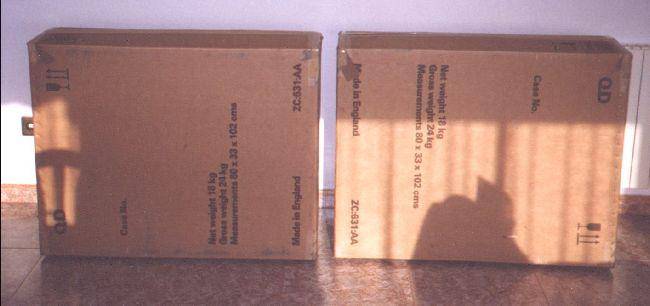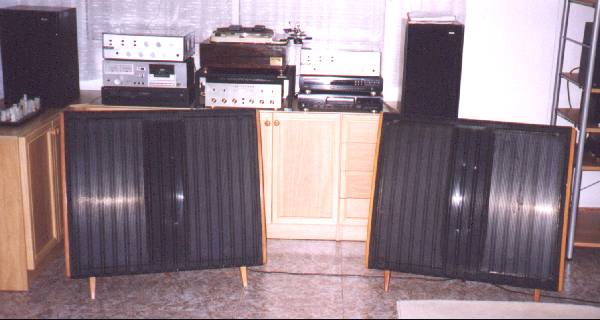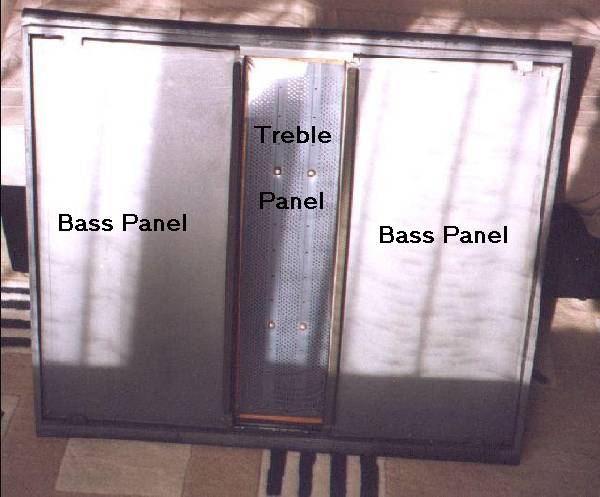



| [ Univers 57 ] |
This section is devoted to an unique hi-fi component. It is the Quad ESL 57, the first electrostatic loudspeaker in the world.
The first theoric approach to the design of an electrostatic loudspeaker was published in Wireless World magazine in 1955. More or less then, Mr. Peter Walker, Quad founder and owner, was studying the design of a loudspeaker with the same characteristics. So he decide to build the first electrostatic loudspeaker available in hi-fi market, the Quad ESL (ESL states for Electrostatic Loudspeaker), also known as Quad ESL 57 (1957 was the year of its definitive introduction in the hi-fi market). By the same time one of the components used in building process of the 57 was also presented. This was the Mylar, by DuPont. So Mr. Walker was lucky and his decission was reinforced by the availability of this material. The first units were available at the end of 1956 and the price was 34-40 pounds. Paying this amount of money you got one loudspeaker, because the 57 was designed to use in mono mode. But with the arrival of stereo recordings the first design was changed (from the unit with serial number 409) to work with the new stereo records. So the price for both units was 80 pounds, an important amount of money in that days.
From the beginning of its life the ESL 57 has been considered a truly reference in audio world and now are very respected everywhere. The 57 were built until the beginning of the 80s, when they were replace by the ESL 63, also replaced recently by the ESL98 and ESL989. Considering that they're not available for the last 20 years, its actual value is very high and they are a very desirable audiophile item. For this reason it is possible to find audio specialists with the ability to repair or refurbish these units to factory specs. If you want to buy a pair in good condition you must be ready to pay 500 pounds, more or less. But the problem is to find them! The person who owns a pair of 57 don't want to sell his units. The best advice I could give to you is to search for a pair in the country of origin of the speakers, I mean UK (see below to get more info on this theme).
But, what about the sound they produce? With 100 dB maximun SPL, the ESL 57 is what we could call a "perfect loudspeaker". It doesn't have the problems that we could find in the cones used in loudspeaker desing, but they are limited in bass extension reproduction (they can't go down below 50 Hz.). On the other hand they give the best mid frequencies you can imagine, specially with vocals. The loudspeaker almost dissapears in the listening room. Due to its limitations with bass it is usual to use a subwoofer with the units (Gradient SW57, approved by Quad. See links below) or to combine two pairs of ESL 57, it's what we call "stacked pairs". This is also useful to control impedance of these speakers (see text below). The best example of stacked pairs was Mark Levinson's approach. That system was known as HQD: Hartley woofer, Quad stacked panels and Decca tweeter. Also in this system the ML-2 Amplifiers were used. These amps were massive class A amps delivering 25 watts and able to control the difficult impedances present in the ESL 57. Another good example of stacked Quads is the system used by Alastair Robertson-Aikman, founder and owner of SME.
About impedance...The impedance in the 57 vary with frequency between 15 and 30 ohms (sometimes between 60 ohms and less than 2 ohms). So we must partner the speakers with good amplifiers. Valve amps are the best choice for the ESL. If we use solid state amps we can damage seriously the amplifier. So be careful! Another important question with the quads is the output power of the amplifier used to drive them. The ESL was designed with low power valve amplifiers in mind (the rule in late 50s). In fact the ideal partner is the Quad II monoblock power amplifier (15 watts, class A) a very good choice -if not the best- for the 57. If you try to use a more powerful amplifier be careful. More power can cause problems to the treble panel, due to arcing. Arcing occurs when the treble panel arcs due to excess of power and touches the stators (electrically charged panels). The result of arcing is.. the dead of treble panel.
Due to the operating principle of these speakers -electrostatic charge- the 57 will attract all the dust around them. So perhaps you will need to clean the panels in a future or when buying a second hand pair. This is a very dangerous operation. First of all, due to high voltages inside the 57 and second due to fragility of the Mylar covering the panels. So...unplug the 57 for a whole day before opening them and when cleaning the Mylar take the maximun care. And, remenber.. be very careful.
More things ....Hi-Fi News and Record Review magazine in their January 2000 issue has elected the Quad ESL 57 "Best audio product of the 20th century".
Where could you find more information about ESL 57? or Where can I buy a pair of ESL 57?
There're a lot of pages about ESL 57 panels but you have to surf in the internet to find them. A good starting point is Sheldon Stokes page.
As I said before, Santa Claus came to my town with the ESL 57 on Xmas '99. I bougth them at The Emporium (see link above) after intensive seeking. My Quads were built around 1969. Both with bees-wax encapsulated EHT units (so upgrading the units will be easy. Before serial number 16000 EHT units were inside epoxy-like enclosures. So upgrading was be difficult). I'm not thinking in the upgrade of the units now, but perhaps in a future. The panels in both units are in perfect condition. Only dust was present and It has been removed with care and a wet cloth. Heavy dust has been removed with care using a vacuum cleaner. In the next monts I will proceed with some modifications like:
I will do some interconnects test. I wil use the quads with my Dynaco ST 70, but perhaps in a future I will go for a pair of Quad II monoblocks, who knows.
Here are some images of my ESL 57.




January 2000, Last News! The grilles have been repainted (satin black) and covered (inside) to prevent dust on the panels. In a near fututre I will build the stands porposed by Sheldon Stokes and test some interconnects.
First auditons.. Oh God! They sound great. I'm using them with my Dynaco ST 70 just refurbished by the expert hands of Jorge Bueno from Amptek. The combo sounds great. The 57s have bass! Not to disturb my neighbours, but enough. And they sound powerful, not restricted. I was surprised with these two aspects of the 57s. It a pleasure to listen to them. No fatigue at all. I have to do more intensive listening before giving my last opinion about them but I have to say that all my impressions are positive. A very important question about 57s is positioning. Every owner has to work on positioning to get the best from the 57. And a curiosity.. the sound level is equal at a distance of 1 meter or 5 meters from the speaker. I will give more info in a futute.
February 7th, 2000- As I said some days ago I have been waiting to have enough time to do some tests with speaker cables for the Dynaco ST-70 and Quad ESL 57 combo. The selection of any component to partner with the ESL 57 seems to be difficult. What I can say about cables is that in theory the ideal cable for the 57s is that where the wires of the cable are as close together as possible. This kind of cables have a low inductance and the 57s like this. As you know impedance in the 57s vary with frequency. At 10 kHz, impedance may go down to 1 ohm. If the speaker cable is very inductive the resulting impedance will form a non-negligable voltage divider and pull down the output of the speaker. So the best cable is one with no inductance (impossible) or one with the lowest inductance. So the best cable suited for the 57s should have the wires as close as possible or a solid core.
In this test I have tried, courtesy of Union Musical Werner in Barcelona, the following speaker cables:
August 18th, 2000- After all these months I have been listening to the ESL57 almost constantly. I have confirmed my first impressions about the quality of these speakers. Absolutely! Now I'm using them with my Quad amps (a most natural way). The sound have changed a little bit compared with the sound obtained with the Dynaco. There's more bass, but I think that I have lost some midrange. Vocals are still good but perhaps not as clean as they are with the Dynaco. I think that I will continue using the "all Quad" combo because of sentimental reasons, I mean an all Quad clasic combo form the 60 delivering fantastic sound.
January 28th, 2001- Tada! The miracle! I got another pair of Quad ESL 57 panels! These two units are a present of my friend Ramón Ribo (do you want to see what a hi-fi system is?) and I have found them only a few streets from my home. They have bronze grilles and at first sigth they look great. I have to check this point disassembling the units for cleaning and verifying the panels. The serial number are above 16.000 so they may have the protection circuits installed. I hope that in the next weeks I would offer some pictures of the units and of the whole acconditioning process.
To see the whole aconditioning process, follow the link shown below:
June 21st, 2023- If somebody is asking, "But, did Ernest say that this site was no longer updated?", I only want to say the I'm still listening to my beloved Quad ESL 57 as much as I can. They continue in excellent shape, paired with my also very much appreciated Dynaco ST70 amplifier. Two months ago I replaced all the tubes in this wonderful machine and now it sounds great again. Last weekend I made a video of the combo I'm using more frequently rigth now: Garrard 301 turntable with SME 3009 tonearm and Shure M97x cartridge, Project Phono Box S phono preamp, Amptek 5/10 custom made passive preamp, Dynaco ST70 power amplifier and Quad ESL57 speakers. Here it is.